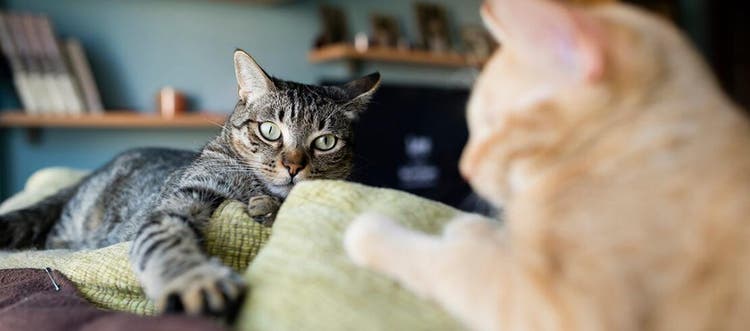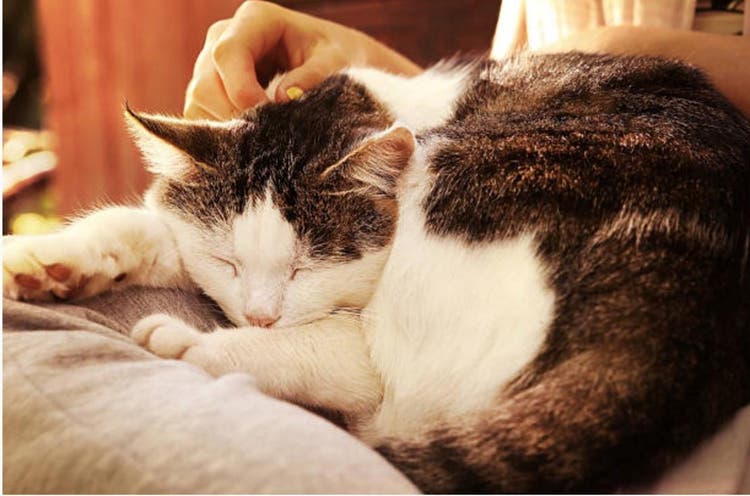Reviewed by Dr Abbie Lam DVM
Is your cat scratching where they aren’t supposed to? Learn how to teach your cat to use a scratching post instead of scratching your furniture, drapes and other areas in your home.
Cats spend most of the time with their claws safely retracted, particularly around their owners. However, without a proper outlet for scratching and claw maintenance, household items like sofas, wallpaper, curtains or carpets might become a destructive outlet for a household cat’s scratching needs.
Understanding the motives behind this scratching behaviour is the first step in stopping it being a problem, while also keeping your cat properly stimulated and happy.
Why do cats scratch?
Cats may scratch objects around the house for a number of reasons, and it’s important to figure out why your cat is scratching before you address the behaviour. The most common reasons cats scratch include:
- To keep their claws healthy: A cat’s claws are constantly growing and renewing, and scratching encourages the outside husks of the claw to come away, revealing new (and sharper) claws beneath. You can often find these husks embedded in or scattered around places your cat likes to scratch.
- To mark their territory: Scratching leaves visual and scent messages to other cats, letting them know that this is your cat’s home. If your cat is scratching near the door or cat flap, this could well be the reason.
- To attract your attention: Cats may seem aloof, but most felines love to interact with people, and scratching can be a way to get you to notice them.
- It feels good: Scratching helps exercise the muscles of the back and shoulders, and it’s pretty obvious from anyone who spends time with cats that they do love a good scratch!
How to stop cats from scratching furniture
Scratching is a healthy and productive self-maintenance activity for cats. By providing your cat with the proper outlets for this habit you’ll keep your cat healthy and your furniture intact. You can help encourage positive scratching behaviour and curb this potentially destructive habit in several ways.
1. Provide an alternative scratching point
If your cat is scratching to sharpen their claws, one helpful solution is to provide a scratching post as an alternative outlet.
Place the scratching post in front of their favourite scratching point and encourage your cat by encouraging them to explore their new post with their paws. Scratching posts are designed with scratching behaviour in mind, and your cat will likely prefer this post over any other household object.
2. Use treats to encourage a new scratching outlet
You’ve been gently and patiently encouraging your cat to use the new scratching post – but they’re not interested. If this is the case for your cat, try using tempting treats.
Place treats on top of the post and give your cat lots of attention when they find the treat. Now try blocking off the old scratching points – hopefully your cat will learn to love the new post over their old scratching spots.
3. Help your cat feel more secure
If your cat is scratching near the door, window or cat flap, they may be feeling insecure in their territory. Here’s how to help your cat feel less stressed:
Install a microchip-activated cat flap: A microchip-activated cat flap provides access to your home only by your cat, which will help them feel more secure indoors. See our guide to teaching your cat how to use a cat flap.
Clean the places where your cat is scratch marking: Removing the smell can discourage your cat from scratching the same spot over and over.
Make your home smaller: Restrict access to a number of ‘non-essential’ rooms to create a more secure environment. Your cat will gradually become more comfortable in the main rooms, like the kitchen, living room and hallway.
Create sitting platforms in high places: Cats love to sit up high. From here, they can survey their territory and feel more confident in the home.
Help your cat scent mark your house: Cats have scent glands in their cheeks and chins, which is why they often rub objects with their faces. Rub your cat’s cheek with a cloth to collect some of this scent, and then rub the cloth around the house, helping your cat feel more relaxed in its territory.
Avoid shouting or punishing your cat for scratching: this can exacerbate their stress and increase the scratching behaviour.
4. Take time to play with and exercise your cat
Many cats love attention from their human friends, but aren’t always sure of the best way to attract it. Your cat may have discovered that while you ignore them when they use the scratching post, you’ll give them attention if they take a few swipes at the new leather sofa. There are many different ways to entertain and exercise your cat.
Spending more time playing with your cat and providing them with toys may help reduce their scratching problem. Additionally, giving your cat ample positive praise and attention when they use the ‘official’ scratching post may also help moderate its behaviour.
Above all, remember that scratching is a natural behaviour for a cat, and with patience and positive reinforcement, your cat can learn to express this instinct on appropriate surfaces like their scratching post.



